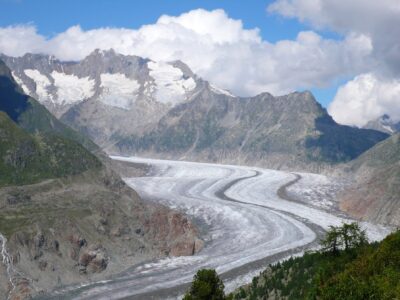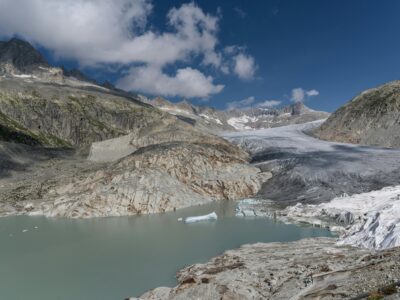
Glacier loss is a pressing concern worldwide, with ice melt impacting freshwater supplies, sea-level rise and ocean circulation. Often, global glacier models are employed to better understand the extent of this threat, such as a recent model that shows widespread deglaciation in mid-latitudes by 2100. However, with this model and others, there are uncertainties regarding any linear relationship between temperature and glacier loss, particularly in regions like Iceland that experience temperature extremes deviating from the global average.
A study conducted on Bruarjokull, a glacier in Iceland, evaluated this uncertainty further, and found that the linear relationship cannot be readily explained by local observations alone. This suggests the need to study Icelandic glaciers as a network. The study, based on this author’s thesis project at Leiden University College in the Netherlands, used satellite imagery and data from the nearest weather station to make a model of the area loss of the glacier from 1984 to 2020. Such retrospective models, called hindcasts, can be used to validate models for projections of future changes.

Traditional methods of studying glaciers involve time-consuming and resource-intensive physical measurements, so researchers sometimes use mathematical models to conduct their work instead. Two types of mathematical models are relevant in this context: deterministic and statistical models. Deterministic models are a type of mathematical model that use physical laws to simulate the behavior of a system. Statistical models, on the other hand, are based on correlations between observed data, and are implemented to make predictions or estimates.
Complex deterministic models on a global scale are not responsive to local weather conditions, so statistical models have emerged as a potential alternative to studying glacier melt. One example of such a statistical model is in the 2001 book Glaciers and Climate Change, by climatologist Hans Oerlemans. He found that stable climate conditions still led to glacier melt in the European Alps. Another example comes from a recent study published in the journal Nature that evaluated glacier retreat of the Naradu Glacier in the Western Himalaya. This study, led by Central University of Rajasthan Professor Rajesh Kumar, came to the conclusion that decreasing precipitation is a more important driver of glacier melt there than increasing temperature.
Prior to the latest study from Iceland, members of our research team attempted to replicate the results of Kumar and his colleagues, using their data and method. After months of data manipulation and attempting to contact the authors to gain more information, we were unable to obtain any of the results published in their paper. This difficulty led us to become curious about the method itself, and we chose to replicate it with new data for Bruarjokull glacier in Iceland.
Iceland is home to some of the world’s largest ice caps, including Langjokull and Vatnajokull. These ice caps and their outlet glaciers are critical components of the country’s freshwater supply, tourism industry and ecosystem. However, climate change is causing them to melt at a rapid rate, leading some to claim that Iceland’s glaciers will disappear in the next 150 years.

The study based on Bruarjokull found precipitation rather than temperature to be the key climate driver of glacier area. This finding contrasts with reports that indicate temperature is the key climate driver of Icelandic glaciers. But the study further finds that linear modeling of Bruarjokull area as a function of precipitation cannot be reliably used for short-term or long-term forecasting of glacier extent.
The nuance lies where one looks at the model residuals—the differences between observed and predicted values of data. The residuals are used when assessing the quality of a model as a diagnostic measure. In this case, the study indicates that glacier-meteorological dynamics may be only partially modeled linearly, but that the model successfully explains underlying trends in the area-precipitation relationship.
While this might sound like a contradiction, it highlights something bigger. A study in Greenland similarly found that individual glacier dynamics are explained non-linearly. However, they show that normalized glacier change is homogeneous over greater regions. In other words, glaciers do not need to be modeled individually to model ice loss as a function of climate in that region. This brings us back to the global glacier models, which can run with reduced computational costs, and model complexity for areas with climate anomalies outside the global average. Whether or not regional modeling applies to Icelandic glaciers cannot be strictly determined from the recent findings, but this does highlight an exciting new opportunity.
Other techniques, specifically non-linear statistical models or artificial neural networks, can be used for local glacier studies. This highlights the need for more sophisticated, comprehensive and expensive data better suited for studying glaciers (as opposed to general weather station data that was used in the study). Obstacles including glaciers’ often remote and treacherous environments suggest that it may not be possible to acquire the data necessary for statistical models to accurately predict glacier melt. In this case, we may need to rethink the methods used for studying Icelandic glaciers, given the limits of the data. By doing so, we can explore connections among regional glacier networks and better inform global models.
Domino Jones is an undergraduate student at Leiden University College in the Netherlands, majoring in Earth, Energy and Sustainability.



